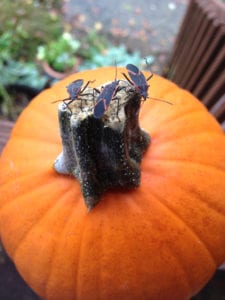 One of the most fun things about the fall season is decorating your home and yard with fall pumpkins.
One of the most fun things about the fall season is decorating your home and yard with fall pumpkins.
However, many people struggle with how to keep pumpkins fresh and how to keep squash bugs away from their festive décor. Pests are problems for pumpkins while they’re still growing on the vine and even after they are picked.
In this article, we will discuss the various types of insects that feed on pumpkins and tips for preserving your pumpkins throughout the fall season.
Insects That Love Pumpkins
This is the time of year that you can enjoy pumpkin-flavored everything – coffee, ice cream, cakes, and pies. But you’re not the only one who loves the taste of this round, orange vegetable.
Beetles, snails, and slugs commonly find their way onto pumpkin and cause serious damage to the plants. Snails and slugs love getting into the flesh of young pumpkins, for example. Squash bugs often destroy the stems and leaves of pumpkins, while squash vine borer insects burrow deep into the vines of pumpkins and deplete their moisture.
What Are Squash Bugs?
Some of the most problematic pumpkin pests are squash bugs. Squash bugs feast on squash, pumpkins, cucumbers, and other plants as well. Squash vine borer insects are different type of pest that also likes to eat these plants. As adults, squash bugs are about 5/8 inch long, have a brown-black color, and have wings.
Squash bugs like to make habitats in dead leaves, vines, and under boards in the winter. Then when it’s time to mate and once vines start forming on plants, they lay eggs under leaves. The damage they cause is largely due to injecting a toxin and sucking the sap out of plants, which causes the leaves to wilt.
How to Get Rid of Squash Bugs
Squash bugs tend to do the most damage to pumpkins when they multiply and create an infestation in large numbers. If you are growing pumpkins, you may need to pick off masses of squash bug eggs a couple times per day. It may also help to place a board in your garden at night to draw squash bugs here and lure them away from plants.
Precise Pest Control is your New Jersey specialist in all types of insect control, including squash bugs. We can help you identify the source of your pest problem and determine the best course of action. Insecticides may be useful if they are applied when the squash bug eggs are hatching. Neem oil may also be used to keep squash bug populations under control.
How to Keep Pumpkins Fresh
To keep your pumpkins looking healthy and fresh, there are some preventative measures that you can take in your yard or garden. In the fall season, it’s a good idea to compost vines from old squash and pumpkins to destroy potential breeding grounds. Since insects that like to feed on pumpkins also tend to enjoy straw and hay, it’s smart to avoid deep mulches like this in the areas around your pumpkins.
Companion planting is a useful strategy for many pest problems, including preventing squash bugs while growing pumpkins. You can plant nasturtium or tansy, for example, around your pumpkins and squash to minimize the risk of pests. Certain varieties of squash are more resistant to insects, such as butternut squash and royal acorn squash, so keep that in mind while shopping for seeds.
If you’re only displaying cut pumpkins in your yard as decorations, there are ways to keep pumpkins fresh once you have decorated them or carved them into jack-o-lanterns. Make sure to store uncarved pumpkins in a cool and dry place, away from sunlight and dampness. For carved pumpkins, you can prolong rot (and squash bugs) by patting the inside of them with a paper towel and spraying the interior with a mix of vinegar and water. Some people swear by placing silica beads, like the ones found in packing materials, into the pumpkin flesh too!
We hope that you’ve found this information helpful and that your pumpkins are healthy and strong this fall. Please call us with any pest issues that you encounter, and we’ll be happy to help!





